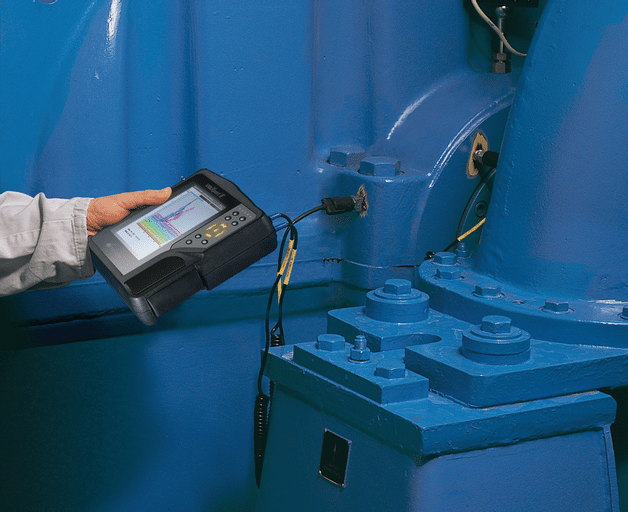
With today’s innovative handheld vibration analyzers, your team can perform route-based condition monitoring even without a vibration expert on staff. Less experienced technicians can collect accurate vibration measurements, then the data can be reviewed remotely and analyzed by your experts or if needed, external consultants.
If, like many maintenance teams, you don’t have as many people as you need, sending your most knowledgeable staff from asset to asset may not be the best use of their time. With the right tool, these experts can simply review and analyze asset data to identify potential failures and recommend the next steps. Route-based condition data collection by entry-level technicians can save your team money by making the most of your experts’ time and by detecting failures before they occur.
Here are five keys to success with route-based vibration analyzers:
Fit Your Own Needs
There is no “one size fits all” vibration analysis program. The best route-based vibration measurement practices for your facility depending on your goals, your asset criticality, and your limitations around resources, time, and accessibility.
Think of retirement savings goals — some people think the recommended numbers sound so far out of reach that they never start. What’s most important is just starting. Start with what you can do and then do more as you have more resources.
Even some basic condition monitoring can improve your efficiency by providing you with the data you need to drive your decision-making. With knowledge of asset condition, you can prevent equipment failures before they happen.
Asset Criticality
Route-based data collection does take time and resources. Some of your valuable resources are busy doing other things. Running a successful maintenance program, when you may already not have the people or the budget to do everything you’d like to do, is always a balancing act. Route-based vibration analysis does take time, but the benefits include knowledge of asset condition, less time and resources spent doing unnecessary PMs, and less time spent repairing machines you could have caught before they turned catastrophic.
Choosing the right assets to monitor with handheld vibration measurement devices will help you get the most out of your time.
Smart tools, like the VibXpert II, make getting accurate, repeatable measurements easier, even for less experienced or even entry-level technicians.

Prioritize Safety
Some facilities have assets that are in hazardous or hard-to-access places — behind panels, up high, or in enclosed spaces, for example. In some cases, mounting vibration sensors on these machines and monitoring them remotely makes sense. But, when it comes to balancing hardware cost, implementation, time, resources, and accessibility, measurements with handheld vibration analyzers often still make sense for these types of assets.
Going in and taking handheld measurements on machines that are either inaccessible or up high or in a hazardous area does raise safety concerns. Even if you do want to opt for remote monitoring with sensors, you may not be able to implement that immediately. But the assets still need monitoring in the meantime.
Remember that it’s much safer to take measurements when the situation isn’t urgent. It’s better to safely go in and find a way to get the data, even if it’s a little bit challenging than to worry about it after a machine fails. Emergencies lead to more accidents than routine repairs or routine data collection — sometimes people rush and sometimes they bypass safety. With routine route-based data collection, properly prioritized for safety, you can take your time and do it the right way.
If your team is working in a hazardous environment, you may also need a handheld vibration meter that has EX-certification as “explosion proof.” The VibScanner 2 Ex makes fast and accurate machine vibration measurements and can be used in a number of different environments.
Start with a Pilot Program
You don’t have to start with every asset you’d like to include. Instead, start small and grow. Get some success under your belt rather than trying to add too much at once. And when choosing assets for your pilot program, go for the low-hanging fruit. That is, choose simple machines and choose machines that are prone to failure.
Once you’ve proven the ROI of adding a handheld vibration analyzer, you can get buy-in from your team and from leadership. The asset condition data collected and analyzed can provide insights that help you optimize your maintenance actions. Consider:
- Am I doing unnecessary PMs?
- Can I reduce my emergency repairs?
Over time, you can transition from reactive repairs and PMs that aren’t necessary to more of a proactive approach of trending asset data and finding answers and the next steps in it. Route-based vibration measurement can help you move away from responding to issues after they happen to identify them in advance.

Take Advantage of Connected Reliability
Data on its own is not a solution. Tracking and trending data, sharing data with your team or other experts, and generating work orders based on data collected are a few ways of making condition data into something actionable. Pairing route-based vibration measurement with a computerized maintenance management system (CMMS) software takes individual data points and puts them into perspective.
A cloud-based CMMS can bring together handheld tools, remote sensors, analytics software, and remote analysis to make the most of your asset data. From work orders to reporting, you can keep your team connected to what matters most to them.
Additionally, if your team doesn’t have the time or knowledge required to analyze route-based vibration measurements, consider hiring a remote team of experts — like Fluke Reliability — to analyze that information and send reports back to you. Talk to one of our experts to find out more about what’s possible with condition monitoring services.





